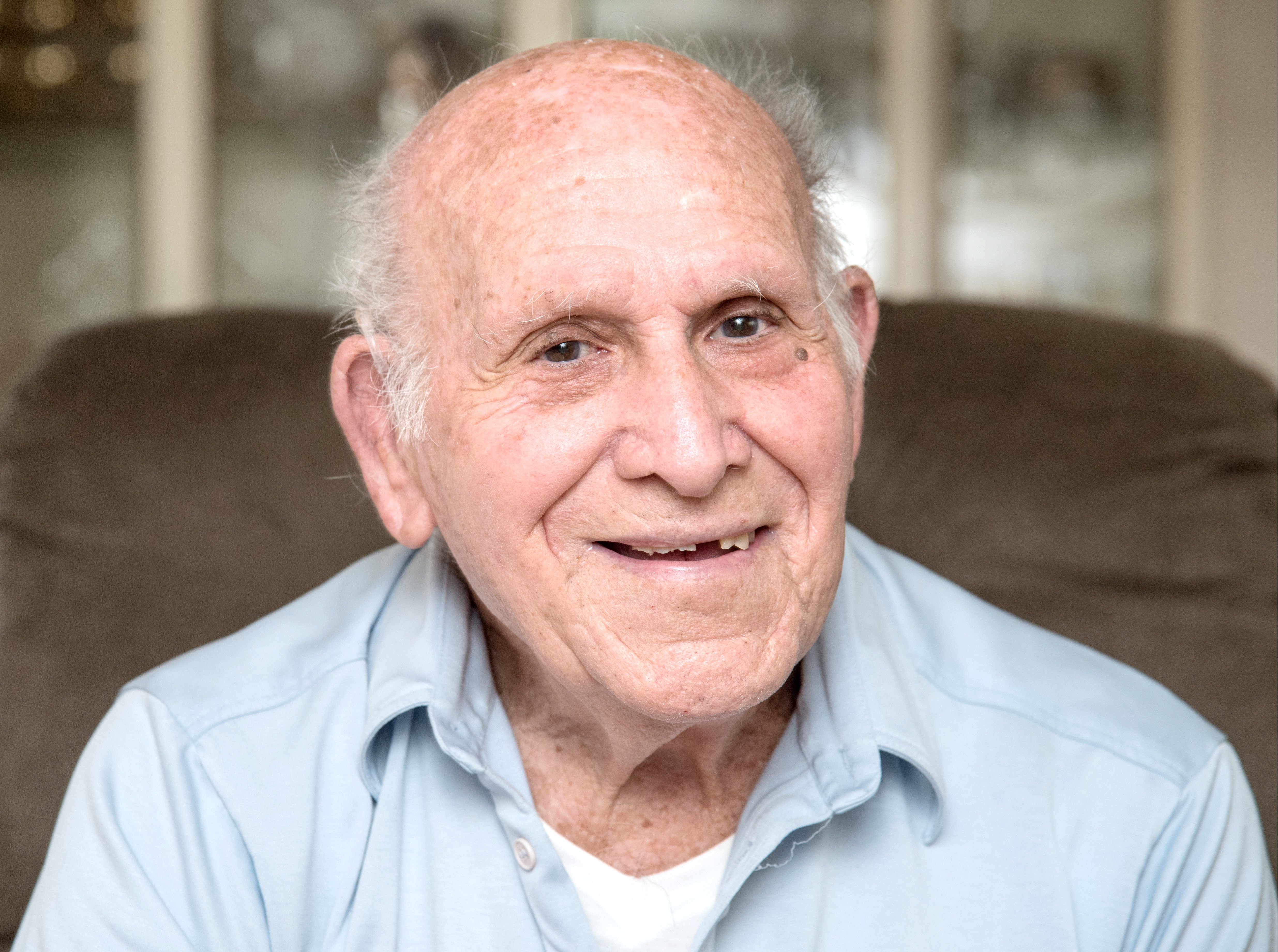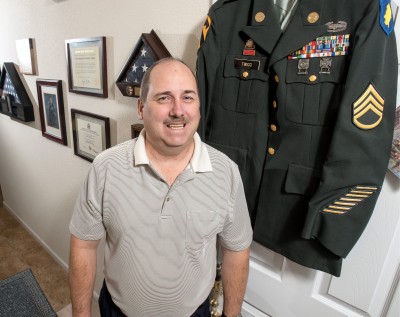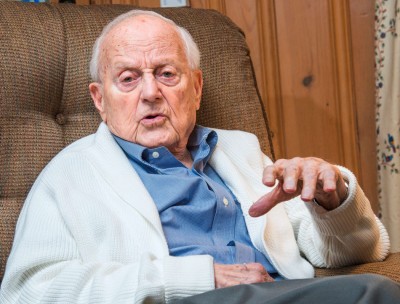Michael Palmisano
By Paul Wood

Photo By Rick Danzl/The News-Gazette
CHAMPAIGN — In a Philippine Islands jungle in World War II, Japanese snipers picked off American soldiers from the trees.
Michael Palmisano remembers a buddy raking the trees with a machine gun, and seeing the dead enemy snipers hanging from their perches.
“They were tied to those trees,” he says.
Palmisano, 94, earned the Bronze Star for one three-week stretch where his unit protected engineers as they repaired bridges behind the enemy lines, all the while under small arms fire from snipers and other Japanese soldiers they couldn’t see in the foliage.
Besides that prestigious medal, Palmisano has been remembered for his service, including an Honor Flight to Washington in 2011.
But he never got one medal he deserved, the Purple Heart.
Palmisano was wounded in the leg by a machine gun on another island in the Philippines.
“But they put a tourniquet on it pretty fast, and they sent me right back to the front,” he recalls.
Because the wound wasn’t treated in a hospital or otherwise entered into the records, the Purple Heart never came.
But the staff sergeant was pleasantly surprised to find a Bronze Star waiting for him when he returned from the war.
Born in Champaign, Palmisano entered the Army in the summer of 1944 and took basic training in Texas.
He took a troop ship from San Francisco to the Philippines and joined the 21st Infantry, nicknamed Gimlet. Many Hawaiians were in his unit, which was sent to Leyte and fought there through most of November 1944.
From there, the 21st moved on to another island in the Philippines, Mindoro, and then on to Mindanao.
It was rough duty. Soldiers lost their shovels and used their helmets to dig foxholes; helmets also served temporary duty as kitchen utensils and for shaving.
They were careful to have grenades at the ready at the sides of their foxholes.
“If you heard some noise out there, you tossed a grenade,” Palmisano says.
That meant being extra careful your own buddies didn’t shoot you.
“You didn’t get out of that foxhole even to go to the bathroom at night,” he says.
With the bridges repaired, U.S. tanks could cross. Palmisano said the only way to dislodge dug-in Japanese troops sometimes was a tank’s flamethrower firing into a pillbox.
While still in the Philippines, Palmisano and his men heard that the war with Japan had ended.
“We weren’t sure whether we could believe it,” he says. “Finally, all of us were hugging each other.”
Palmisano’s time in the Pacific did not come to an end then. He spent six months in Japan, often staying in former enemy barracks.
He didn’t see many Japanese.
“We were driving around and the Japanese would stay inside,” he says.
One of his unit’s tasks was to take Koreans, who had been put under Japanese control during the war, to the north of Japan to be ferried home.
Palmisano got home in May 1946, spent some quality time with wife Catherine and daughter Rosalie Shahan, and worked for a while at Chanute Air Force Base in Rantoul, now closed.
His father-in-law, Dominic Buttitta, was a bricklayer, and thought the veteran might be good at the job.
He was, and did it for 50 years.
“I finally quit the union, but I did the last of the work when I was 90,” says Palmisano, who built his own house and the one next to it.
His most amazing job was the steeple at Wesley United Methodist Church in Urbana, at the time the tallest structure in town.
“A helicopter had to drop part of that in, and I sealed it,” he recalls.
Do you know a veteran who could share a story about military service? Contact staff writer Paul Wood at pwood@news-gazette.com.
Read more stories from local veterans:
 Patrick J. Twigg
CHAMPAIGN — Retired Staff Sgt. Patrick J. Twigg served overseas in Operations Desert Shield and Desert Storm and Iraqi F …
Patrick J. Twigg
CHAMPAIGN — Retired Staff Sgt. Patrick J. Twigg served overseas in Operations Desert Shield and Desert Storm and Iraqi F …
 Morris Hecker
CHAMPAIGN — Morris Hecker was bombed and strafed on his LST — an acronym that he jokes stands for “Long, Slow Target.” L …
Morris Hecker
CHAMPAIGN — Morris Hecker was bombed and strafed on his LST — an acronym that he jokes stands for “Long, Slow Target.” L …
 Matt Kreeb
GILMAN — Sgt. Matt Kreeb was eager to serve his country. The Iroquois West grad served in the prestigious and demanding …
Matt Kreeb
GILMAN — Sgt. Matt Kreeb was eager to serve his country. The Iroquois West grad served in the prestigious and demanding …